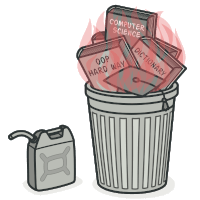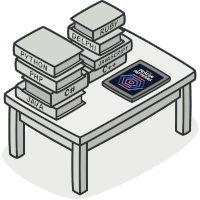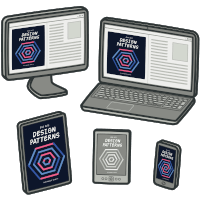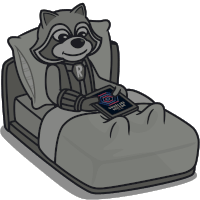디자인 패턴에 뛰어들기
디자인 패턴은 소프트웨어 디자인에서 일반적으로 발생하는 문제를 해결하는 데 도움이 됩니다. 그러나 이미 만들어진 라이브러리나 함수들을 복사해서 사용하는 것처럼 그냥 패턴을 찾아 프로그램에 복사할 수는 없습니다. 왜냐하면 패턴은 구체적인 코드 조각이 아니라 특정한 문제들을 해결하기 위한 일반적인 개념이기 때문입니다. 패턴은 코드에서 반복되는 디자인 문제를 해결하기 위해 맞춤화할 수 있는 청사진들을 미리 만들어 놓은 것이라고 생각할 수 있습니다.
이 책 디자인 패턴에 뛰어들기에서는 22개의 클래식 디자인 패턴과 이러한 패턴이 기반하고 있는 8가지 디자인 원칙들을 자세히 설명합니다.
- 책의 각 장에서는 실제 소프트웨어 설계 문제를 언급하는 것으로 시작하며, 패턴 중 하나를 사용하여 이를 해결합니다.
- 그 후 패턴의 구조와 변형들에 대해 자세히 살펴본 다음 코드 예시를 살펴봅니다.
- 그런 다음 패턴의 다양한 적용 사례들을 보여주고, 패턴을 단계별로 구현하는 방법을 기존 프로그램에서도 구현할 수 있게 알려줍니다.
- 각 장은 패턴의 장단점에 대한 논의로 마무리되며, 다른 패턴과의 관계, 유사점 및 차이점에 대해서도 탐구합니다.
왜 패턴을 알아야 할까요?
인터뷰와 업무 수행 평가에서 두각을 나타낼 수 있습니다. 패턴에 대한 질문은 거의 모든 프로그래밍 관련 취업 면접과 업무 수행 평가에서 나타납니다. 패턴을 배워 더 많은 프로젝트를 따내고 급여 인상과 승진까지 받아보세요.
당신의 프로그래밍 툴킷을 확장할 수 있습니다. 패턴을 사용해 문제를 해결하면 시간을 낭비하지 않고 이미 만들어진 해결책을 커스터마이징할 수 있습니다. 그러면 숨겨져 있는 모든 문제를 다루는 검증된 표준 해결책을 사용하기 때문에 코드에 실수가 적어집니다.
직장 동료들과 더 잘 소통할 수 있습니다. 한 시간에 걸쳐 다른 프로그래머에게 당신의 멋진 디자인과 클래스의 세부 사항을 설명하느라 시간 낭비하지 말고, 그냥 패턴 이름을 공유하세요.
이 책은 누구를 위한 책인가요?
패턴 초보자에 적합합니다. 패턴을 공부해 본 적이 없으신가요? 이 책에서는 실제 예시와 함께 객체 지향 프로그래밍의 기본 원리를 설명합니다. 패턴에 대해 알아보기 전에 패턴이 만들어지는 디자인 원칙들과 가치들을 살펴봅니다.
패턴 복습에 적합합니다. 패턴을 예전에 공부해 본 적이 있다면, 전자책을 참고해 잊어버린 내용을 복습하실 수 있습니다. 또 책을 처음부터 끝까지 읽지 않고도 관심 있는 부분을 빠르게 찾아볼 수 있습니다.
새로운 프로그래밍 언어를 배우는 데 적합합니다. 객체 지향 언어(예: C#, C++, 다트, Go, 자바, PHP, 파이썬, 러스트, 루비, 스위프트, 타입스크립트) 중 하나를 공부하고 있다면 유용한 삽화와 다이어그램을 포함하는 실제 사례들과 비유들을 통해 책의 중점 내용을 금방 소화할 수 있을 겁니다.
무료 데모
책의 품질을 직접 확인해 보세요. 데모 버전에는 목차, 몇 장의 서문, 세 가지 디자인 원칙과 팩토리 메서드 디자인 패턴이 포함되어 있습니다.

100% 만족도 보장
지금 아무런 리스크 없이 주문해 보세요. 주문 후 한 달 내로 책이 별 도움이 되지 않는다고 생각되시면, 당사에서 어떤 것도 묻지 않고 모든 금액을 환불해 드립니다.
다른 사람들은 뭐라고 하나요?
Everything is well explained and I like the way all basics are introduced first (UML, SOLID) and then we can go on each design pattern and play with it. The only improvement I see is making printed version available (I prefer paper to pdf) and maybe in another languages.
Your book is great. I am junior level developer and certainly happy with the purchase! I like the structure of how each pattern is presented, and the UML and examples really clarify things. I also like the "vibe", which keeps it fun yet on-point. I can't think of a con. Thanks for this!
The book is awesome, easy-understanding and well-written. Just have a little suggestion to organize the content not in alphabetical order but by categories would be better. And also put some code in it [rather than having it in separate archive] so that it would be easier to read on an iPad when travel.
I read it the same day I got it, I mostly use it as a refresher on on when I dont see the woods for the trees. I think it's fine the way it is.
I have been really busy with work recently. The info you have on design patterns has been a huge help and an excellent reference!
I think what you have currently is well done and the organization is superb!
I only had time to glance at the book but it seems really amazing. I hope to have time since next month to read it.
About the things that made me to buy it are the cartoons and UML diagrams that simplifies the understanding of each pattern. I really like them!
I would like to suggest you to do something similar (including cartoons) with the most famous programming antipatterns.
I have just read the book and I think it is amazing. I have bought both of your patterns books and refactoring course and if you need me to buy from you again I will :)
So far I find this book very interesting and useful in terms of examples/diagrams and ideas. I wish you could have the code written in Java.
I am loving the book so far. I'm currently reading it on my Kindle. I'll use it to make dojos with some friends of mine so that we practice the principles of the book.
As for suggestions, maybe it's a bit too soon to say since I'm still at the beginning and I'm a slow reader, but maybe exercises? I don't even know if the book presents exercises. Maybe it does and I didn't get there yet.
The book is great and makes all the patterns more easier to understand than the books or examples i found on the internet.
I like your style of writting, it`s easy to understand. You are going from the problem to the solution and that process give me the best understanding about pattern.
Comparations betweem patterns are helpful alot.
Maybe the UML diagrams should have cardinality and the role that a class plays in the relationship because it's difficult for the first reading for every problem follow all properties from the code or from the text.
Maybe for some patters you should use the same problem, saving time to understand the new problem but to concentrate just on pattern, and make good comparision of new pattern with the old one. Well it's good to have more different problems for diversity but it's more time consuming and little blury the pattern.
I have already started reading the book, though I'm not quite half way yet. My impressions so far is that I like it! I enjoy the UML diagrams high diagrams explaining the connections and the coding examples. I also appreciate the explanation on when to use a particular pattern and what are it's strengths and weaknesses. There is a lot of good information and I have been re-reading sections to make sure I have a firm understanding as to why a particular pattern is beneficial and how to properly implement it before moving on.
The book is great! I discovered your site a few months ago in my ongoing quest to design better code. I bought the book because it has information on SOLID design principles, and I like that I can read it on a Kindle. I'm a big fan of the illustrations - they're funny and do a good job of illustrating the concepts.
I'm a long-term user of your website refactoring.guru from as early as my undergrad era. I have to say the website (refactor.guru and design patterns) are great! It's the 101 for me to learn how to improve my code in a higher level than just learning grammars and best practices of programming languages.
To me, the e-book is a modernized Design Patterns: Elements of Reusable Object-Oriented Software. Although I've purchased the old Design Patterns book long before and put it on my bookshelf, I seldom read it. Your book changed this awkward situation, because it has a much better look and more readable contents. It also have updated understandings of trade-off, nice illustrations and better summaries for each of the design patterns. Much more attractive to me. And the book is well organized by chapters, letting me to read it through many times on my phone during leisure time.
Sincerely, it's perfect as an e-book to me as a guidebook to improve my skills as a software developer and I have recommended the book to all of my friends. Yet I'm wondering if there is a further plan to make a more "advanced" version. What I mean is that a version with more detailed explanation with the theories behind these design patterns, probably citing some academic researches of software engineering, some industry cases, etc. This advanced book will be the best choice for people who want to dive even deeper into the story behind the scene. Its form might be somehow like that of Peopleware and Pragmatic Programmer where the author introduced the experiences by telling stories or some industry cases they know.
Another advice is that it might be a good business decision to make a paper-based version of the e-book. I believe almost every programmer will be willing to put one on his/her shelf. I noticed the e-book has some hyperlinks as part of the organization. But I believe it's possible to make some arrangement to minimize the jumps and make it highly sequentially readable.
Again, thank you so much for creating the awesome website and book. It's a huge help to me. The thing is that I found trade-offs in software engineering cannot be taught easily in universities. So in the past a newgrad have to spend several years to learn these experiences by working in a big company for years. However, this might not be everyone's ideal career path. Your website and book made it all flatten and now a newgrad or student can learn very quickly by using your website. It enabled an agile career path directly from a startup (or even "non-profit" career path by simply start to working on open-source projects).
I did read your book. Twice. It is a very comprehensive book and a joy to read and to walk through. It serves great as a reference and I probably won't need another reference book for patterns. I like your writing. No lengthy fluff, no excessive jargon, no just dry code. To the point. Also I like the way you explain the design and SOLID principles. Thank you very much.
What I would like to see more in the book is a reference to typical, real life use cases of each pattern. For example, I have heard the command pattern can be used to radio groups or for writing wizards. How is this done? Are there any examples of real life code using the visitor pattern? Are there any simple examples we can study? No need for extra book pages, just a link to a online repo with code examples probably would do. Maybe more examples would help the stick better to the memory.
Yes, it is up to me to come up with good use cases for each pattern but as a newbie I find it difficult to remember what each pattern does and what it is good for. Some, like the singleton, the facade, the observer etc. are obvious and easy to remember their purpose and general functionality, others not so much.
Also it would be great if there was an option for a dead tree version of the book. I want to keep it as reference. I will feed the PDF to my laser printer but I would like to have it printed and bound looking like a real book.
All and all I give your book a solid 5 stars. Thank you very much.
I've read a considerable part of the book already. I loved what I read! You explain the concepts in such an easy way. I wish I had the opportunity to read it when I was in college. I don't have, currently, any suggestions to improve it. But it would be great if it were available in more languages. Since I'm from Brazil, I'm not gonna lie, it would be great to have it in Portuguese (so I could tell my non-English speaking friends to get it as well, 'cause they really need some of the knowledge in the book).
I stumbled across your website when searching "why refactoring is important" if I'm not mistaken. I immediately saved it to my bookmarks that day and shared it with some of my colleagues.
Thank you for the book.
I like your book, it is easy to understand even if I'm not good in English and really really beginner, of course the illustrate each pattern make me smile, real world example and class diagram help me better understanding, relation between pattern really help me to understand when and why pattern exist.
I hope you can write code in JavaScript, because sometime I convert the code into Typescript/ES7
I am half way through the design patterns book and I must say I am more than 100% happy that I purchased the books. I must say you have a knack of telling the things in the right way. I am really enjoying the book and I am very sure even the refactoring book would be great as well.
I like the way topics are presented and the examples. That helped be get the context and better understand them. This way, I will not forget the concepts over a period of time. I wish the SOLID principles content should be expanded a little more by taking a real world complete use case and applying step by step like before and after. I know this kind of thing may be tricky to make, but, it would help.
Moreover, I would suggest breaking the design pattern book in to design patterns and also OOAD book. The OOAD book can focus on SOLID principles, OOP in general and how OOAD can be done. The design patterns then can augment the same.
I am glad to have purchased the books and they will definitely help me in understanding and applying them at my work. Keep up the good work. I will be watching out for any new content that you put out.
I like the way you have explained each of design patterns although I have the original GoF books but it's really hard to understand.
No suggestion as of now I am still in between and I am happy with my purchase. Thanks!
The Design Patterns are something I was not very familiar with. I already learned a lot from your book and I hope I will be able soon to get a new role in my career and maybe to teach other people about the patterns.
Everything is explained very well, the introductory part includes SOLID and fundamentals of OOP which is very good. I would do more examples if I could. What I would put here is a brief of symptoms of a bad design like rigidity, fragility, imobility and viscosity. But for me, it's exactly what I was looking for - design patterns with explanations and concrete examples in one place. And to be honest it was at the best price - personally I wouldn't do it for this amount.
Thank you again and congratulations for your work. I would be glad to share you my pieces of code in the future if you want. Good luck!
This is a very good book you have. This is well explained at the level of the principles and through examples.
My only concern is my level of English which is very low and it takes me a lot of time to understand the quite complex designs. I am a symfony developer and currently I am in the process of deciding the use of these patterns at the framwork level.
The use of SOLID is quite understandable and I think it is the basis, so I did not have the same problems for the factory. It's the others that I'm investing more. I found, for example, that symfony formlaries are rich enough to find use cases (factoryMethod, builder, composite).
This will interest me a lot if you can help me find the use of the symfony designs.
I'm still reading the book, but so far I really like it! It has been a helpful refresher to me on OOP principles. I liked the explanation of UML diagram symbols.
I'm relatively new to design patterns, but you explain them in a very clear manner which is easy to understand. I enjoy the illustrations and the real-world examples. Other material I had previously read on design patterns was pretty abstract without saying how it would be helpful in real life. But your book makes it all very clear!
The book is really awesome and explains the concepts in great detail. I read the book completely and I think its the fastest I completed any book.I am also considering to buy the other book on code refactoring.
The improvements I would like to see in the book is to add some more design patterns. I guess some design patterns from the Gang of Four missing and also some patterns outside GoF which we use most often. Some information on Anti patterns & code smells and also examples of how multiple patterns can be used together within applications would be great.
I would like to thank you for your excellent book. It's one of the best purchases I have recently made and has helped me a ton with work.
I've read the book as soon as I got it after I had read through the examples available on your website, because it convinced me that the information in it would be very useful to me. Since I have got your book, I have kept it open at work on one of the displays as a reference and guidelines for my designs and whenever I extend the functionality of my software I always follow the design patterns presented in the book.
What I love about the book is that it is a recent and modern document about design patterns, which is in my experience the bread and butter of object oriented software design. It is very concise, provides many examples and very concrete applications, and actual implementations in all the programming languages I use at work. While the information in the unavoidable "Gang of Four" design patterns book is very good on its own and a great text, I was looking for a book in the same scope, but a recent one to keep up with the new designs, technology and concepts that come and your book is a perfect candidate for that.
The text itself is pretty, with very nice diagrams and images, great formatting and typesetting. While these are details, they make the information much more readable and enhances the whole experience. And the cover art is very nice !
I honestly have no idea on how to improve the book. It has been a pleasure to read, and has become a very important tool at work and one of my "definite references", so it's difficult to improve something you are already very satisfied with !
So, thank you again, props to you for making this great text. The first recommendation for books about design patterns and object oriented software design that I would give would be definitely yours, hands down.
I’ m very happy with the book. It’ s easier to read than a GoF book.
- I can’ t say anything bad.
- Complex structures are explained in an easy to understand way.
- I believe it would be great if a few chapters on anti-patterns were added.
Overall, thank you very much for the high-quality material.
I liked everything, I read it only once for now. And I have not yet found anything that could be improved. I keep it in my favorites as a reference book.
I use your website, and bought the book to support the project! I like everything very much. Simple and user-friendly! Keep it up!
To my surprise, the book is very well suited for different levels of specialists. That’ s why we even added a link to your website as a recommendation.
I enjoyed the illustrations and the method of presenting the material. Thank you for popularizing useful educational materials.
I believe the presentation is ideal: brief, without unnecessary discussion. A clear description of the problem, a way to solve it, a pseudocode: all you need is there. Illustrations also help a lot. If I need to remember why one or another pattern is needed, I just look at the picture and I remember everything.
This is what could be improved, in my opinion. Maybe a few more examples of the practical application of a particular pattern. Without a code. Just a description of the situation and its solution using a pattern. I.e. real-life examples. I am, of course, more interested in Web development.
I'm reading the book right now. The website has almost everything that is written in the book, so technically I could have just read about it on the website. As to what could be improved, it is difficult to say. Sometimes you write about the same thing over and over 10 times, but many of us (including myself) need it for initial understanding.
I would love to see more examples, maybe even without code. For example - you can talk with developers from different industries and ask around, where and how they apply this or that pattern.
I’ m an Android developer and some of your patterns are stacked on commonly occurring screens. Maybe you should add some links to designs of other guys as an example.
But overall the book is quite good. The pictures are cool. Sometimes it's hard to figure out what's what, but what can you do? We must persevere. Read again, try again.
It would be great to see the version for Kotlin. I actually rewrite your examples in order to learn the language.
I started reading the book, and I'm very pleased with it. Great, high-quality examples and schemes.
My first impression is a positive one, the author should continue writing. I'd like to buy the book for a friend. I understand that the only option is to register under a new account.
I previously studied these patterns in the book titled “The Gang of Four” . I liked the simplicity of descriptions in your book, as well as the excellent usage examples. I use your book as a reference guide in order to refresh my knowledge about a particular template or to search for a template I may need at the moment. I can't say anything about how the book can be improved, because I haven't even thought about it.
The author did a great job creating this book)
Thanks for the great material! I'm reading the book in sections, I really like how the material is presented, user-friendly presentation on several levels, interesting examples, clear illustrations. I can't help but compare it to Freeman's “Design Patterns” , and the presentation in your book is more informative in my opinion. It is convenient not only to read the book in a sequential order, but to also use it as a reference guide.
I plan to use the materials you have collected to put together training materials, reports inside and outside my company, in the context of front-end development.
Truth be told, I bought the book to give back for the work the authors did when creating the website, it helped me and continues to help + I was interested to see how SOLID will be outlined.
I think it would be cool for newbies if there were c# examples as well, although everything is quite clear anyway. Since I have a stable Internet connection, I use the website as a reference guide instead of the book.
I'm reading the book, it's interesting, not boring, and it offers quite an exciting and fresh perspective. I would love to see it a paperback edition as well.
Thank you for the book. The material is presented beautifully and in a user-friendly manner. The examples are clear, the diagrams are accurate, the illustrations are interesting. It works as a reference book, as well as an introductory guide for the topic. I use it for both purposes.
I work as a C# developer. I had read an article online that included many references to patterns. I went to Google and found your website, where I read about the pattern that was of interest to me. Your information is very well structured, but what I liked the most was the style of illustrations. There is something home-like about them)) As a beginner, I really liked the fact that the patterns are described from the point of view of the issues that they solve, and not from the standpoint of the description of the pattern itself. After reading the entire section on patterns on the website, I realized that I wanted to buy the book to thank you for the work you have done collecting and structuring the information.
I would like to comment only on one section - “Relationships with other patterns” . Despite the fact that I read about all the patterns, I still don't understand what this section is about. Maybe you could add illustrations there, or even remove this section altogether and add a chapter about using combined patterns?
The project as a whole, and the book in particular, make an excellent impression. It would seem that there are quite a lot of books written on this topic, but you have structured everything and made it rather fun) Wonderful illustrations that help readers memorize everything in a fun way.
I started reading the book right after I purchased it. I've already learned how to apply a couple of the described patterns quite confidently in practice.
The book can be improved by publishing it on paper. That way you can give it as a gift, for example.
I would like to see examples for PHP and Python, but as I understand, you are already working on it.
Thank you for your work, and good luck in your endeavors!
I am completely satisfied with the purchase, I have already read the book from cover to cover. I think that this is the most user-friendly book on patterns I have ever read. I was really happy that I could read it on my iPhone. Thank you for the great book!
Excellent book, everything is explained in detail and presented in a user-friendly manner. Special thanks for supporting multiple formats and providing the readers with the ability to read the book on the go.
I liked the book; from time to time I apply the solutions from the book in my work.
I'm pleased with the book and very thankful for your work.
I would like to note right away that the book is beautifully illustrated) The information about SOLID, and in particular, about the principle of Barbara Liskov, is presented very well and in a user-friendly manner. I found some new information for myself about the private members of the base classes and the fact that you explicitly separate the restrictions on preconditions by type and attribute values. It is really easier to figure everything out this way.
It seemed strange that the book is over 30mb, though
The book is great. Excellent illustrations and examples. I am now preparing a report on Design Patterns at work.
What can be added: examples with Anti-Patterns, what not to do.
I do really enjoy your book. And would like to buy printed version to have it on my work place.
Everything that is explained using cats is always clear, and the more allegories the better. I haven't finished the book yet, but the first impression is rather good, thank you!
I confirm that I bought this book, and am satisfied with the purchase, otherwise I would not have bought it :)
I was looking to find some information on the most widely used patterns (builder and factory), and I ended up finding the materials on the website. And everything after that is history - I really liked the design of the website and its structure; other similar resources usually just have a description of random ~5 patterns, and the rest are “coming soon...” .
Your website is by far the BEST of all that I have come across on this topic, and that's why I bookmarked it and added the PDF version to the offline library on my tablet. Although I am an experienced “pirate” , I am always happy to pay an ADEQUATE price for the product that I use for my professional activity.
I almost finished reading the book. I will say right away that I liked it; the book offers real-life examples, the descriptions and the pseudocode are good.
The material is interesting, even though it was a bit unusual to learn on examples with pseudocode. For pros, this approach is, of course, quite acceptable. In general, the book is definitely worth its price.
무엇을 받게 되나요?
4가지 포맷으로 구성된 다국어 전자책
- 포맷: PDF, EPUB, MOBI
- 언어: 한국어, 영어, 중국어, 일본어, 프랑스어, 포르투갈어, 폴란드어, 러시아어, 스페인어, 우크라이나어
- 페이지 수: 439 페이지
- 그래픽: 225개의 삽화와 다이어그램
- 업데이트와 수정은 무료입니다.
코드 예시가 담긴 저장소
- 예시들은 다음 언어들로 제공됩니다: C#, C++, 다트, Go, 자바, PHP, 파이썬, 러스트, 루비, 스위프트 및 타입스크립트.

읽기 쉽게 자연스러운 언어로 작성된 전자책. 최소한의 전문 용어와 최대한의 코드 예시 및 일러스트로 작성되었습니다.

특정 프로그래밍 언어에 한정되지 않습니다. 코드 예시는 의사 코드로 작성되었으며, 의사 코드에서 설명된 원칙들은 대부분의 현대 객체 지향 언어에 적용할 수 있습니다.

어떤 기기에서든 읽을 수 있습니다. 전자책은 4가지 포맷으로 제공됩니다.
- EPUB 포맷은 휴대폰 또는 태블릿에서 읽기에 적합합니다.
- MOBI 포맷은 아마존 킨들 사용자들에게 적합합니다.
- PDF 포맷은 인쇄 또는 모든 기기에서 읽기에 적합합니다.

항상 편리하고 검색이 가능합니다. 전자책은 편리한 참고서입니다. 종이로 된 책과는 달리 검색이 가능하고 분실이 불가능하며 스마트폰, 태블릿, 노트북 또는 데스크톱에서 언제든지 사용할 수 있습니다.

출퇴근할 때나 휴식 시간에 즐겁게 읽을 수 있습니다. 침대, 버스, 비행기, 또는 지하철 내에서 방해받지 않고 패턴을 배울 수 있습니다.

밤에도 쉽게 읽을 수 있습니다. 올빼미족에게 희소식입니다! 이 전자책은 낮에는 밝은 배경에서, 밤에는 어두운 배경에서 읽기 좋습니다.
자주 하는 질문
더 궁금하신 점이 있으신가요?
저희에게 포럼 메시지를 보내시거나 support@refactoring.guru로 이메일을 보내주세요. 보통 수 시간 이내에 답변해 드립니다.
 겨울 세일!
겨울 세일!




